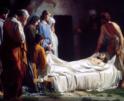
Faith
The Triduum continues on Friday, called Good Friday, not because what happened to Jesus was good, but because what happened to Jesus was and is good for you and me -- the redemption and the offer of salvation.
The Paschal Triduum begins with the Evening Mass of the Lord's Supper on the evening of Holy Thursday. There is a degree of festivity, and the liturgical color is white or gold.
The Mass of this day is like a parish's Sunday Mass with two significant differences.
First, there is the Washing of the Feet, which is optional, but one rarely hears of the option of not having it chosen. The Missal does not offer options other than the Washing of the Feet. Nor is there any indication that this is a washing of the feet of all members of the assembly by one another.
Then, there is the Procession to the Place of Eucharistic Reservation, which is not optional but does admit of possible variations.
The place for reservation may be elsewhere in the church or even in another place on the parish property. Parishes that have a lower church often use that. More often, a special altar of reservation is arranged at a distance from the altar for Mass. It is usually splendidly decorated.
The procession itself can be one that weaves its way through the church or through the upper church to the lower church or to a side chapel, perhaps regularly used for daily Mass. The longer the procession, the more easily members of the assembly can move along the processional route to the place of reservation.
The place of reservation, if possible, should be available for visits by the faithful until midnight, when the period of adoration ends. An appropriate way to end this period is with the celebration of Night Prayer from the Liturgy of the Hours.
Older readers recall the Seven Churches when, on Holy Thursday, pilgrim parishioners would move from their home parish to six or seven other churches to visit the Blessed Sacrament and offer a brief prayer at each Altar of Reservation. This custom is seeing a bit of a revival in parishes. Dioceses with many parishes, especially urban ones, find this a bit easier to accomplish. Since there is no requirement that you walk from church to church, one could either individually or in a small group drive from those that are farther apart. Some parishes even offer a bus for the pilgrimage.
This Holy Year, with its theme "Pilgrims of Hope," might be a good chance to make a local pilgrimage of Seven Churches.
The Triduum continues on Friday, called Good Friday, not because what happened to Jesus was good, but because what happened to Jesus was and is good for you and me -- the redemption and the offer of salvation.
Mass is not celebrated this day. The liturgy of this day is Friday of the Passion of the Lord. Nevertheless, the bishop or priest who is the principal celebrant wears red Mass vestments.
There are three parts to this liturgy. There is an interesting history of this day from doing nothing except perhaps visiting the sites of the Lord's Passion (which could only happen in Jerusalem), or listening to the Proclamation of the Passion from one of the Four Gospels, or venerating the cross, especially after the True Cross was found and relics were brought from Jerusalem to all corners of the globe.
Our Good Friday consists of a Liturgy of the Word with readings that are invariable every year and includes the proclamation of the Passion according to John. The Passion is more effectively proclaimed with the various parts distributed among several readers and the entire assembly.
Then, there is a more solemn and extensive Universal Prayer or General Intercessions. In fact, these petitions provide the model for the petitions we pray at every Mass.
During the Good Friday liturgy, the cross is brought into the church and makes three stops: at the back, the middle, and the front of the church. These same stops will be repeated at the Easter Vigil, this time with the Paschal Candle. Once the cross has been placed for veneration, the members of the assembly may approach it and make a reverence of their choosing to the cross.
The cross remains in the sanctuary for the remainder of the liturgy and even after the assembly departs.
Lastly, there is the Communion. The Eucharist is brought in silence from its place of reservation. A simple set of prayers accompanies our preparation to receive the Eucharist. This is the only time when all the assembly receives Holy Communion from previously consecrated hosts reserved in the tabernacle.
When Holy Communion has been distributed, and the remaining hosts are brought to the place of reservation, which is not the tabernacle in the church, there is a prayer after Communion and a prayer over the people. Then, they all depart in silence.
Recent articles in the Faith & Family section
-
Holy Thursday and Good FridayFather Robert M. O'Grady
-
Faith is a verbArchbishop Richard G. Henning
-
Giving Mothers and Babies a Chance in the MissionsMaureen Crowley Heil
-
'The Chosen: Last Supper' premieres in Dallas, bringing Holy Week to the big screenFather Patrick Briscoe
-
Be free: Experiencing the promise of the Jubilee YearDr. R. Jared Staudt























